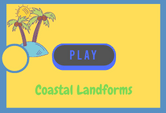Coastal Landforms: Islands vs. Peninsulas Game Quiz Online
This page features a Coastal Landforms: Islands vs. Peninsulas Game Quiz Online. It is an exercise for students studying science in 3rd, 4th, 5th, 6th to 8th grades. Students will learn about coastal landforms in this activity Remember to learn more by readding the article below.

When you next visit the shoreline or travel to the sea, odds are you’ll encounter a few islands or even a peninsula. They might even be considered local landmarks. The features and identities of these bodies of land have been shaped by the sea, but can you tell an island from a peninsula? We’ll see.
The Factors That Define Coastal Landforms
Generally, a coastline is created by erosion and deposition. These processes all impact the shape and size of coastal landforms. These processes are crucial for the survival and development of coastal communities.
Tidal currents
Intense tidal currents are a common feature of coastlines and are responsible for shaping many natural and man-made landforms. They are characterized by varying intensity and duration, and can be either diurnal or semi-diurnal. The latter has the benefit of varying water movement within a bay, especially narrow coastal embayment. Furthermore, the tidal range determines the vertical distance over which waves shape the shoreline and determines the size of the intertidal zone.
Erosion
Sea level rise and storm surges are two of the primary causes of coastal erosion. These natural events affect coasts across the world, and erosion is particularly severe in some areas. Because the severity of coastal erosion varies from region to region, there is no one solution that will solve the problem across the board. Nonetheless, coastal landforms need to be protected to ensure continued human use and enjoyment.
Deposition
The processes that shape coastal landforms are complex and varied, and the characteristics of parent material play a key role in the creation of different forms. Factors such as the presence of inland, upstream, and local materials can all influence the landforms that are deposited. In addition, ocean contents can also affect the formation of certain landforms.
Waves
The process of erosion by waves can create a variety of unique coastal landforms. They cut into rocky shorelines and form notched coastlines. Wave energy is concentrated on cliffs, creating a wave-cut notch. Wave erosion also creates a flat offshore terrace. The resulting erosion produces sand, which is often deposited at the base of these landforms. This process is also called refraction, and it is important to understand the process of erosion and how waves alter coastal landforms.
Gravity
Gravity plays an important role in coastal processes. Along the coast, it is directly involved in the downslope movement of rock and sediment. The most obvious manifestation of this is along shoreline cliffs. Waves undercut the cliffs and attack their base, resulting in erosion and the accumulation of debris at the base.
Estuaries
Estuaries are coastal landforms in both freshwater and saltwater environments. In fact, 22 of the world's 32 largest cities are situated on estuaries. They are also very productive ecosystems, and are a great source of energy and recreation. But they are not without flaws for construction. There are some specific features that should be considered before constructing on a new estuary.
Barrier islands: Manmade and natural
Studies of the evolution of barrier islands in Mississippi suggest a postulated origin. The islands are manmade and well-nourished and lie off the Mississippi delta plain. A nearby island, Sand Island, is well-nourished because it lies in the path of abundant longshore drift. A postulated origin would be in line with recent observations of similar islands in coastal regions of the United States. However, there are some other explanations for the formation of these unique landforms.
Spits
Spits are deposition landforms that form off coasts. They are formed when waves ebb and flow away from the coast, causing longshore drift to spread out. The sediment that spits drop helps build the bar out from shore. In addition, they provide protection from stronger waves.
